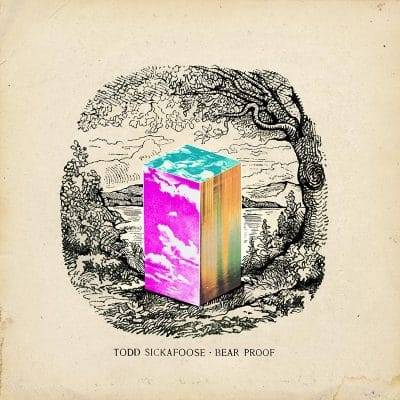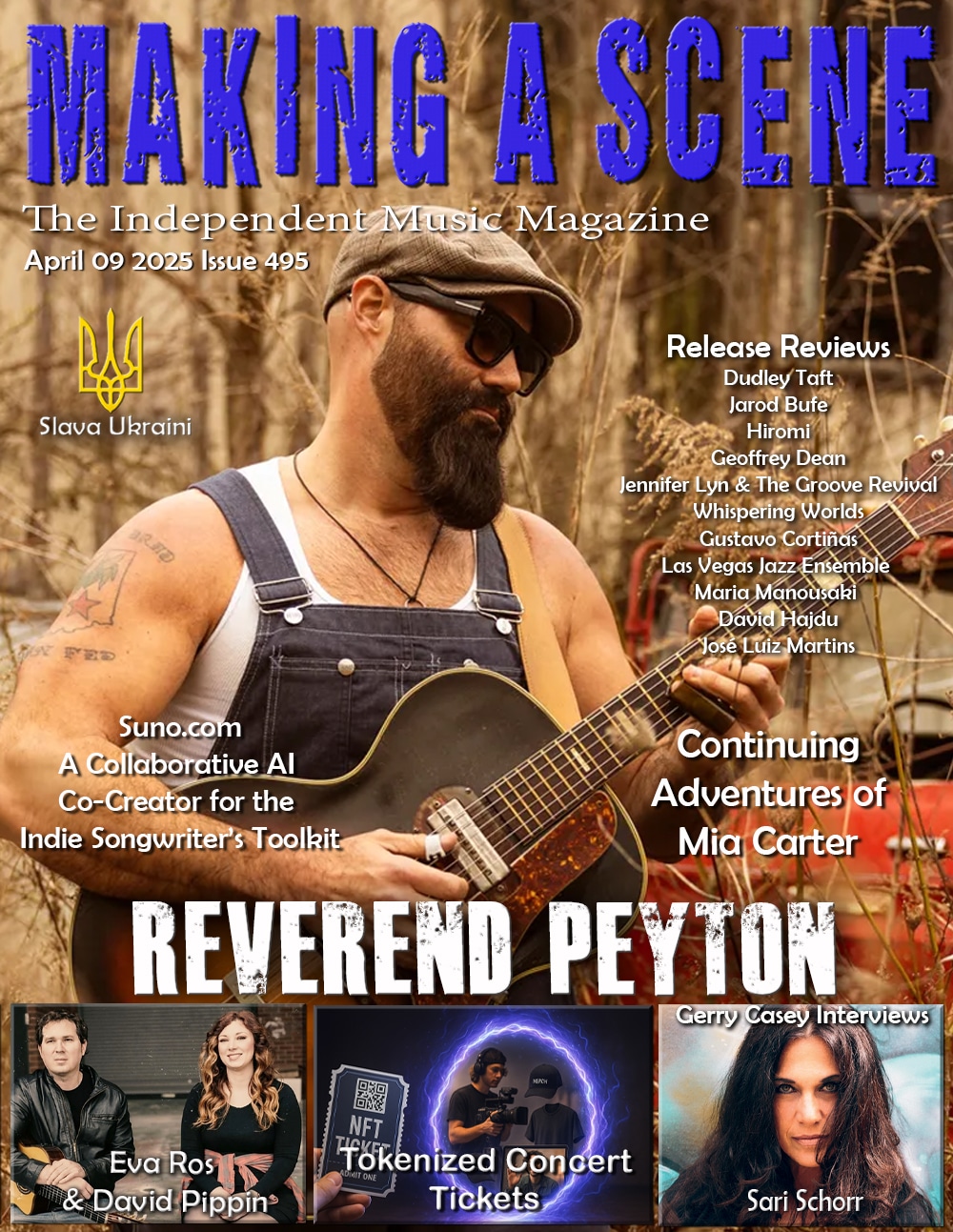Todd Sickafoose Bear Proof
 Todd Sickafoose
Bear Proof
Secret Hatch
Bear Proof is 62 minutes of continuous music by a super group of creative musicians led by Tony and Grammy-winning bassist, composer, and producer Todd Sickafoose. The album was recorded in the since shuttered Fantasy studios (Berkeley, CA) and the delay in getting it issued likely attests to Sickafoose’s busy schedule and perhaps that of his premier octet too. Given that the recording took place in the Bay Area, as Sickafoose terms it, it’s a “surreal meditation on boom and bust.” San Francisco’s population is shrinking due to the preference for remote work and the cost of living. Oakland has seen the departure of two of its three professional sports franchises and is about to see the third. The future of both cities is as bleak as ever. So, while the title evokes a camping term, which we could naturally associate with the Eugene, OR-based Sickafoose, in this context it is a kind of skin one puts on, to protect against the downturn. Yet, as the multi-directional musical narrative unwinds, it will likely bring to mind all kinds of thoughts, not one cohesive theme. The beauty is in the rather unique instrumentation and the talents of the eight musicians, many of whom are bandleaders, and many of whom play in several genres. All but three have played with Sickafoose before.
They are violinist Jenny Scheinman (who has her own band, Parlour Game, and often plays with Bill Frisell), guitarist Adam Levy (Norah Jones, Scheinman, Sickafoose, and many others), keyboardist Erik Deutsch (currently with the Black Crowes), cornetist Kirk Knuffke (James Brandon Lewis, Matt Wilson, Butch Morris), Allison Miller (Scheinman, Artemis, Boom Tic Boom), accordionist Rob Reich (Tin Hat, Gaucho, Circus Bells), and clarinetist Ben Goldberg (Trevor Dunn, Marty Ehrlich, Tin Hat). As you may glean several of these musicians have history with one another, not mention that Levy and Miller graced Sickafoose’s 2008 Tiny Resistors.
“The Gold Gate” opens and the four phases of its three notes find their way into the other pieces as the music evolves. The interplay between these instruments creates an immense dynamic range and moods that range from dark to majestic. The sounds refract and echo off each other. “Bent Into Shape,” led by Goldberg and Knuffke is disarming and foreboding with its floating tempo that has Levy and Reich on additional ride cymbals. Miller develops a distinct rhythmic pattern for “Switched On” as Levy’s guitar, Knuffke’s rousing cornet, and Goldberg’s clarinet dart in and around percussive beats. Scheinman solos midway through as Sickafoose also takes to the bow, underpinning her soaring lines, building a dramatic crescendo that also dissolves for deliberate statement from Knuffke that ignites more orchestration, ultimately resolved in a fading decrescendo. Piano notes and bouncy sequences color the bright piece “Flush,” with Goldberg as the featured soloist. As the piece builds Miller’s beats and Levy’s chords add a rock element, yet in the last couple of minutes the energy dissipates to lighter wavelike (i.e., Twilight Zone) patterns punctuated only by Sickafoose’s robust plucking.
Levy states a melancholic melody to begin “Magnetic North,” which Sickafoose cites as the halfway point – “I think of the whole first half as descending down, down to that moment, then everything resets, and the second half begins.” The tempo takes on a bluesy, slow marching rhythm, featuring guitar, bass, and drums with the others weaving a dreamy soundscape that moves into the forefront midway through until it lingers, suspended for a good two minutes until Knuffke’s cornet sounds like the distant cry of a wolf emerging through the fog. The piano coda at the end picks up on the three-note motif of the opening “The Gold Gate” before another bluesy sequence ensues with “Boom Bust Startup Ruin.” Knuffke and Goldberg intersperse their lines around edgy rhythms and plucked strings from both Scheinman and Sickafoose as Deutsch and Reich interject ominous chords, collectively producing an intriguing cinematic soundscape that grows chaotic after a brisk, gleeful skipping rhythm develops but, like in so many other sections, disappears and morphs into the bluesy riffs that initiated the piece.
“Turns Luck” begins with a few emphatic notes, emblematic of what one might expect after ‘the dust has settled.’ The tone then seems to connote momentum and perhaps a well-staged rebuilding of sorts. (Again, read your own imagery into it). Deutsch is the featured soloist with the full ensemble playing brightly toward the end, ceding the final voice to Goldberg. The segue into “Prospects” is totally seamless but consider its inception when Knuffke makes his entrance. The cornetist then authors a soaring, flowing, triumphant statement that then gets obscured by dense, dark strings and Deutch’s piano ostinato. The octet swells to a crescendo before landing on one suspended figure that leads into “Reverse Fortune,” with its plodding rhythm, single notes, and dark tones expressing a solemn reverie, a story without a happy ending, stamped by one powerful, definitive chord.
Strap yourself in and prepare to do nothing else for 62 minutes. Close your eyes and soak in the many colors. Music does not get more vividly brilliant.
Todd Sickafoose
Bear Proof
Secret Hatch
Bear Proof is 62 minutes of continuous music by a super group of creative musicians led by Tony and Grammy-winning bassist, composer, and producer Todd Sickafoose. The album was recorded in the since shuttered Fantasy studios (Berkeley, CA) and the delay in getting it issued likely attests to Sickafoose’s busy schedule and perhaps that of his premier octet too. Given that the recording took place in the Bay Area, as Sickafoose terms it, it’s a “surreal meditation on boom and bust.” San Francisco’s population is shrinking due to the preference for remote work and the cost of living. Oakland has seen the departure of two of its three professional sports franchises and is about to see the third. The future of both cities is as bleak as ever. So, while the title evokes a camping term, which we could naturally associate with the Eugene, OR-based Sickafoose, in this context it is a kind of skin one puts on, to protect against the downturn. Yet, as the multi-directional musical narrative unwinds, it will likely bring to mind all kinds of thoughts, not one cohesive theme. The beauty is in the rather unique instrumentation and the talents of the eight musicians, many of whom are bandleaders, and many of whom play in several genres. All but three have played with Sickafoose before.
They are violinist Jenny Scheinman (who has her own band, Parlour Game, and often plays with Bill Frisell), guitarist Adam Levy (Norah Jones, Scheinman, Sickafoose, and many others), keyboardist Erik Deutsch (currently with the Black Crowes), cornetist Kirk Knuffke (James Brandon Lewis, Matt Wilson, Butch Morris), Allison Miller (Scheinman, Artemis, Boom Tic Boom), accordionist Rob Reich (Tin Hat, Gaucho, Circus Bells), and clarinetist Ben Goldberg (Trevor Dunn, Marty Ehrlich, Tin Hat). As you may glean several of these musicians have history with one another, not mention that Levy and Miller graced Sickafoose’s 2008 Tiny Resistors.
“The Gold Gate” opens and the four phases of its three notes find their way into the other pieces as the music evolves. The interplay between these instruments creates an immense dynamic range and moods that range from dark to majestic. The sounds refract and echo off each other. “Bent Into Shape,” led by Goldberg and Knuffke is disarming and foreboding with its floating tempo that has Levy and Reich on additional ride cymbals. Miller develops a distinct rhythmic pattern for “Switched On” as Levy’s guitar, Knuffke’s rousing cornet, and Goldberg’s clarinet dart in and around percussive beats. Scheinman solos midway through as Sickafoose also takes to the bow, underpinning her soaring lines, building a dramatic crescendo that also dissolves for deliberate statement from Knuffke that ignites more orchestration, ultimately resolved in a fading decrescendo. Piano notes and bouncy sequences color the bright piece “Flush,” with Goldberg as the featured soloist. As the piece builds Miller’s beats and Levy’s chords add a rock element, yet in the last couple of minutes the energy dissipates to lighter wavelike (i.e., Twilight Zone) patterns punctuated only by Sickafoose’s robust plucking.
Levy states a melancholic melody to begin “Magnetic North,” which Sickafoose cites as the halfway point – “I think of the whole first half as descending down, down to that moment, then everything resets, and the second half begins.” The tempo takes on a bluesy, slow marching rhythm, featuring guitar, bass, and drums with the others weaving a dreamy soundscape that moves into the forefront midway through until it lingers, suspended for a good two minutes until Knuffke’s cornet sounds like the distant cry of a wolf emerging through the fog. The piano coda at the end picks up on the three-note motif of the opening “The Gold Gate” before another bluesy sequence ensues with “Boom Bust Startup Ruin.” Knuffke and Goldberg intersperse their lines around edgy rhythms and plucked strings from both Scheinman and Sickafoose as Deutsch and Reich interject ominous chords, collectively producing an intriguing cinematic soundscape that grows chaotic after a brisk, gleeful skipping rhythm develops but, like in so many other sections, disappears and morphs into the bluesy riffs that initiated the piece.
“Turns Luck” begins with a few emphatic notes, emblematic of what one might expect after ‘the dust has settled.’ The tone then seems to connote momentum and perhaps a well-staged rebuilding of sorts. (Again, read your own imagery into it). Deutsch is the featured soloist with the full ensemble playing brightly toward the end, ceding the final voice to Goldberg. The segue into “Prospects” is totally seamless but consider its inception when Knuffke makes his entrance. The cornetist then authors a soaring, flowing, triumphant statement that then gets obscured by dense, dark strings and Deutch’s piano ostinato. The octet swells to a crescendo before landing on one suspended figure that leads into “Reverse Fortune,” with its plodding rhythm, single notes, and dark tones expressing a solemn reverie, a story without a happy ending, stamped by one powerful, definitive chord.
Strap yourself in and prepare to do nothing else for 62 minutes. Close your eyes and soak in the many colors. Music does not get more vividly brilliant.
- Jim Hynes
Discover more from Making A Scene!
Subscribe to get the latest posts sent to your email.















































